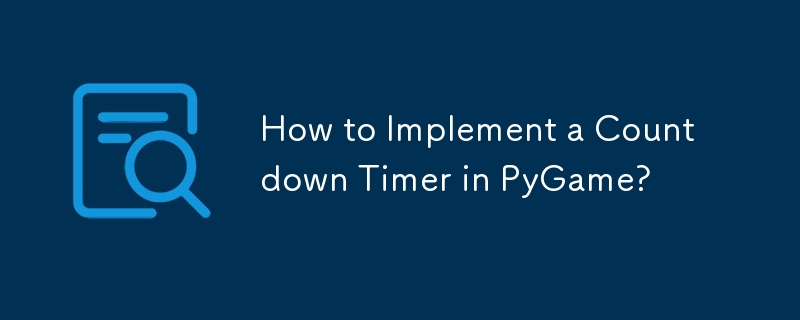Found a total of 10000 related content

How to Create a Countdown Timer in Pygame?
Article Introduction:Countdown Timers in PygamePygame is a popular library for creating games in Python. One useful feature to include in games is a countdown timer....
2024-12-02
comment 0
575

How to Implement a Countdown Timer in PyGame?
Article Introduction:Countdown Timer Implementation in PyGameCreating a countdown timer is essential for various game elements, such as timed levels or explosive...
2024-12-04
comment 0
646



Build a Countdown Timer in Just 18 Lines of JavaScript
Article Introduction:Building a JavaScript countdown clock is sometimes necessary, whether it is an event, a promotion or a game. You can build the clock using native JavaScript without relying on any plugins. While there are many excellent clock plugins, using native JavaScript has the following advantages:
The code is lightweight and has zero dependencies.
The website performs better without loading external scripts and stylesheets.
With more control, you can precisely control the behavior of the clock without trying to flex the plug-in to suit your needs.
Here is how to create your own countdown clock with just 18 lines of JavaScript code:
To gain an in-depth understanding of JavaScript, please read our book "JavaScript:
2025-02-10
comment 0
627

How to output a countdown in C language
Article Introduction:How to output a countdown in C? Answer: Use loop statements. Steps: 1. Define the variable n and store the countdown number to output; 2. Use the while loop to continuously print n until n is less than 1; 3. In the loop body, print out the value of n; 4. At the end of the loop, subtract n by 1 to output the next smaller reciprocal.
2025-04-04
comment 0
1367

How to install Chinese plug-in with vscode
Article Introduction:Steps to install Chinese plug-in in VSCode: Search for "Chinese" in the extended market. Select and install the required plugins. The plug-in will be automatically enabled after installation. If you need to enable it manually, please click "Enable" in the plug-in list. After installing and enabling the plug-in, it is ready to be used.
2025-04-15
comment 0
648

Efficient way to install VSCode plug-in in batches
Article Introduction:An efficient way to install VSCode plugins in batches is to use command line tools. The specific steps include: 1. Export the plug-in list: run code--list-extensions>extensions.txt. 2. Bulk installation of plug-ins: Run catextensions.txt|xargs-n1code--install-extension, so that plug-in configurations can be easily synchronized between different environments.
2025-05-15
comment 0
317


Use tips and recommendations for the VSCode plug-in market
Article Introduction:To better utilize the VSCode plug-in market, first use advanced search functions to filter the plug-in, secondly install and uninstall the plug-in, and finally make full use of the plug-in functions and maintain them regularly. 1. Use keywords and advanced search functions (ratings, downloads, release dates) to filter plugins. 2. Click "Install" to install the plug-in, and click "Uninstall" to uninstall the plug-in. 3. It is recommended to use Prettier, GitLens and LiveShare plugins, and regularly review and update the plugins to optimize performance.
2025-05-15
comment 0
606

vscode installation Chinese plug-in vscode how to install Chinese plug-in vscode
Article Introduction:VS Code's Chinese plug-in can significantly improve development efficiency, especially for non-native English developers; it is recommended to choose plug-ins released by official or well-known developers and view user reviews to avoid potential pitfalls such as inaccurate translations or conflicts with other extensions.
2025-04-15
comment 0
632

How to delete sublime plug-in
Article Introduction:There are two ways to delete plugins in Sublime Text: Delete through the Plug-in Manager: Select the plug-in you want to delete and right-click and select "Delete". Manually Delete: Navigate to the user data directory, locate the plugin folder and drag it to the Recycle Bin or Trash.
2025-04-16
comment 0
644

Introduction to how to use the tomtom plug-in in World of Warcraft
Article Introduction:Tomtom is a popular WOW plug-in with automatic path finding function. Users only need to enter their destination and the software will guide them there quickly. The following are detailed steps. We can first download this plug-in on each plug-in platform. Introduction to how to use the Tomtom plug-in in World of Warcraft 1. Please go to the major plug-in platforms to download and install the Tomtom plug-in. 2. After the installation is completed, a green arrow will be displayed in the game to guide you to the mission location. 3. If you need to find a specific item, you can enter its address in the dialog box, such as [/way #2022 53.91 39.03], and the system will automatically plan the route. 4. Finally, click the arrow to reach the specified coordinates.
2024-10-29
comment 0
706

How to dynamically generate code in Hongmeng development Hvigor plug-in
Article Introduction:The steps to dynamically generate code using the Hvigor plug-in are as follows: Create an Hvigor plug-in project. Create a code template and add content that generates the code dynamically. Use code templates in Hvigor and specify parameters using expressions. The dynamically generated code will be executed at runtime.
2025-04-17
comment 0
326

The reasons and solutions for editor crash after VSCode plug-in update
Article Introduction:The reason why the editor crashes after the VSCode plugin is updated is that there is compatibility issues with the plugin with existing versions of VSCode or other plugins. Solutions include: 1. Disable the plug-in to troubleshoot problems one by one; 2. Downgrade the problem plug-in to the previous version; 3. Find alternative plug-ins; 4. Keep VSCode and plug-in updated and conduct sufficient testing; 5. Set up automatic backup function to prevent data loss.
2025-05-29
comment 0
621

How to install and manage GitLab plug-ins in CentOS
Article Introduction:The GitLab plug-in installation and management guide for CentOS system This article will guide you how to efficiently install and manage GitLab plug-ins in CentOS system. Plugin installation steps GitLab Administrator login: Use the administrator account to log in to your GitLab instance. Go to the management page: Click on "Manage" or similar options (usually gears or three dot icons) in the upper right corner of the page. Access Plugin Settings: In the menu on the left, locate and click Settings, and select the Integration or Plugins tab. Search and add plugins: In the plugin list, use the search function to find the plugin you want. Click the "Add Plugin" button, select the target plugin and follow the prompts to complete the installation. Plug-in configuration (if necessary):
2025-04-14
comment 0
579



【ES 3rd Anniversary】Windows-chrome installation of Elasticsearch-head plug-in
Article Introduction:To download the zip file of elasticsearch-head plug-in, you can use the following link: Link: https://pan.baidu.com/s/1fksEifwtAQ-L1DEd21KHZw Extraction Code: 8888 Installation Method 1: Install through Google Chrome First, open Google Chrome, click the "More Tools" option in the upper right corner, and then select "Extensions". Unzip the downloaded es-head.zip file, find the third-party plug-in file with the suffix .crx, and change its suffix to .rar, and then unzip it again to get a folder. After entering the extension page, enable developer mode, and then click "Load the unzipped extension" and select
2025-05-22
comment 0
537



















